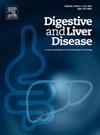肝移植后早期肝硬度测量可预测急性同种异体移植排斥反应
IF 3.8
3区 医学
Q1 GASTROENTEROLOGY & HEPATOLOGY
引用次数: 0
摘要
急性同种异体移植排斥反应(ACR)仍然是肝移植(LT)后的一个重要并发症。目前,诊断依赖于实验室检查和组织病理学标准,这并不总是能够及时诊断和早期治疗。肝刚度测量(LSM)被认为是估计肝纤维化的准确方法;然而,许多其他情况也会影响它,包括坏死性炎症性肝损伤。因此,与ACR相关的炎症过程也可能影响LSM。本研究旨在探讨LSM在预测LT后ACR发展中的潜在预后作用。方法本研究包括所有在2021年9月1日至2023年12月31日期间在Policlinico Universitario A. Gemelli, IRCCS接受原位LT的成人连续患者。我们排除了因急性肝功能衰竭而接受肝移植的患者和出现早期血管或手术并发症的患者。在肝移植后的头14天,每天进行全血细胞计数和肝功能检查。ACR的诊断基于有效的组织学标准(Banff RAI)。禁食至少6小时后,于术后第1、3、7天使用Fibroscan (Echosense, France)进行LSM。结果共纳入70例患者。本研究共纳入65例患者,其中5例患者符合排除标准。中位年龄62岁(IQR 56-66), 80%为男性。15名患者(23%)在肝移植后4周内发生ACR (POD - IQR 7-10)。在POD 1时,发生ACR的患者和未发生ACR的患者之间的LSM无显著差异(分别为15.0 [IQR 10.5-21.7]和17.7 kPa [IQR 12.3-22.4])。与未发生ACR的患者相比,随后诊断为ACR的患者在POD 3和7上的AST和胆红素水平(但不含嗜酸性粒细胞计数)显著高于未发生ACR的患者。在移植后的第一周,发生ACR的患者表现出LSM的进行性恶化,与未进行POD 3治疗的患者相比有显著差异(19.2 [IQR 14.7-27.8] vs 13.7 [IQR 9.9-18.9],分别为0.01)和POD 7 (26.6 [IQR 19.7-31.6] vs 10.5 [IQR 8.8-14.9],分别为0.01)。因此,在发生ACR的患者和未发生ACR的患者之间,LSM随时间的相对变化显著不同(δ % LSM POD3-1: 28.8% [IQR 1.4-63.1] vs -15.1% [IQR -30.3至-5.8],p<0.01; δ % LSM POD7-1: 53.7% [IQR 10.9-101.1] vs -25.2% [IQR -48.1至-15.8],p<0.01)。在logistic回归分析中,δ % LSM POD3-1和δ % LSM POD7-1与同一时间点的δ % AST和δ %嗜酸性粒细胞计数显著相关(OR分别为1.06;CI 1.03-1.10; p<;0.01和OR 1.07; CI 1.03-1.12; p<0.01)。我们观察到,与移植后立即测量的LSM值相比,ACR的发生通常伴随着LSM值的增加,这可能表明肝内炎症反应的进行性发作。值得注意的是,在发生ACR的患者中,LSM的增加比传统上认为提示ACR的其他体征(如胆红素、AST和嗜酸性粒细胞计数增加)发生得更早。因此,移植后早期的LSM可以作为ACR早期诊断和早期治疗的额外工具。本文章由计算机程序翻译,如有差异,请以英文原文为准。
Liver stiffness measurement in the early post-liver transplant phase predicts acute allograft rejection
Introduction
Acute allograft rejection (ACR) continues to be a significant complication following liver transplantation (LT). Currently, diagnosis depends on laboratory tests and histopathological criteria, which do not always enable prompt diagnosis and early treatment initiation. Liver stiffness measurement (LSM) is known to be an accurate method for estimating liver fibrosis; however, many other conditions have been shown to impact it, including necro-inflammatory liver damage. Thus, the inflammatory process related to ACR could also impact on LSM.The present study aims to explore the potential prognostic role of LSM in predicting the development of ACR after LT.
Methods
This study included all adult consecutive patients who underwent orthotopic LT between 1 September 2021 and 31 December 2023 at Policlinico Universitario A. Gemelli, IRCCS. We excluded patients who underwent LT for acute liver failure and patients who develop an early vascular or surgical complication. During the first 14 days after LT, complete blood counts and liver function tests were performed daily. Diagnosis of ACR was based on validated histological criteria (Banff RAI). LSM was performed on post-operative day (POD) 1st, 3rd, and 7th with Fibroscan (Echosense, France) after a fasting period of at least 6 hours.
Results
Seventy patients were enrolled. The analysis involved 65 patients, as 5 patients met exclusion criteria. The median age was 62 years (IQR 56-66), and 80% of the patients were male. Fifteen patients (23%) developed ACR within the first 4 weeks after LT (median at 9 POD - IQR 7-10). At POD 1, LSM was not significantly different between patients who developed ACR and those who did not (15.0 [IQR 10.5–21.7] vs 17.7 kPa [IQR 12.3–22.4], respectively). AST and bilirubin levels, but not eosinophil count, on POD 3 and 7 were significantly higher in patients who were subsequently diagnosed with ACR compared to those who did not develop ACR. During the first week post-transplant, patients who developed ACR showed a progressive worsening of LSM, which was significantly different compared to patients who did not on POD 3 (19.2 [IQR 14.7–27.8] vs 13.7 [IQR 9.9–18.9], p<0.01, respectively) and POD 7 (26.6 [IQR 19.7–31.6] vs 10.5 [IQR 8.8–14.9], p<0.01, respectively). Consequently, the relative change over time in LSM was significantly different between patients who developed ACR and those who did not (delta% LSM POD3–1: 28.8% [IQR 1.4–63.1] vs -15.1% [IQR -30.3 to -5.8], p<0.01; delta% LSM POD7–1: 53.7% [IQR 10.9–101.1] vs -25.2% [IQR -48.1 to -15.8], p<0.01).At logistic regression analysis delta% LSM POD3–1 and delta% LSM POD7–1 were significantly associated with ACR development independently from delta% AST and delta%eosinophil count at same timepoints (OR 1.06; CI 1.03-1.10; p<0.01 and OR 1.07; CI 1.03-1.12; p<0.01, respectively).
Conclusions
We observed that the development of ACR is often preceded by an increase in LSM values compared to those measured immediately post-transplant, possibly indicating the progressive onset of the intrahepatic inflammatory response. Notably, the increase in LSM in patients who will develop ACR occurs earlier than other signs traditionally considered suggestive of ACR, such as increased bilirubin, AST, and eosinophils count. Therefore, LSM in the early post-transplant setting could serve as an additional tool for enabling earlier diagnosis of ACR and, consequently, earlier treatment.
求助全文
通过发布文献求助,成功后即可免费获取论文全文。
去求助
来源期刊

Digestive and Liver Disease
医学-胃肠肝病学
CiteScore
6.10
自引率
2.20%
发文量
632
审稿时长
19 days
期刊介绍:
Digestive and Liver Disease is an international journal of Gastroenterology and Hepatology. It is the official journal of Italian Association for the Study of the Liver (AISF); Italian Association for the Study of the Pancreas (AISP); Italian Association for Digestive Endoscopy (SIED); Italian Association for Hospital Gastroenterologists and Digestive Endoscopists (AIGO); Italian Society of Gastroenterology (SIGE); Italian Society of Pediatric Gastroenterology and Hepatology (SIGENP) and Italian Group for the Study of Inflammatory Bowel Disease (IG-IBD).
Digestive and Liver Disease publishes papers on basic and clinical research in the field of gastroenterology and hepatology.
Contributions consist of:
Original Papers
Correspondence to the Editor
Editorials, Reviews and Special Articles
Progress Reports
Image of the Month
Congress Proceedings
Symposia and Mini-symposia.
 求助内容:
求助内容: 应助结果提醒方式:
应助结果提醒方式:


